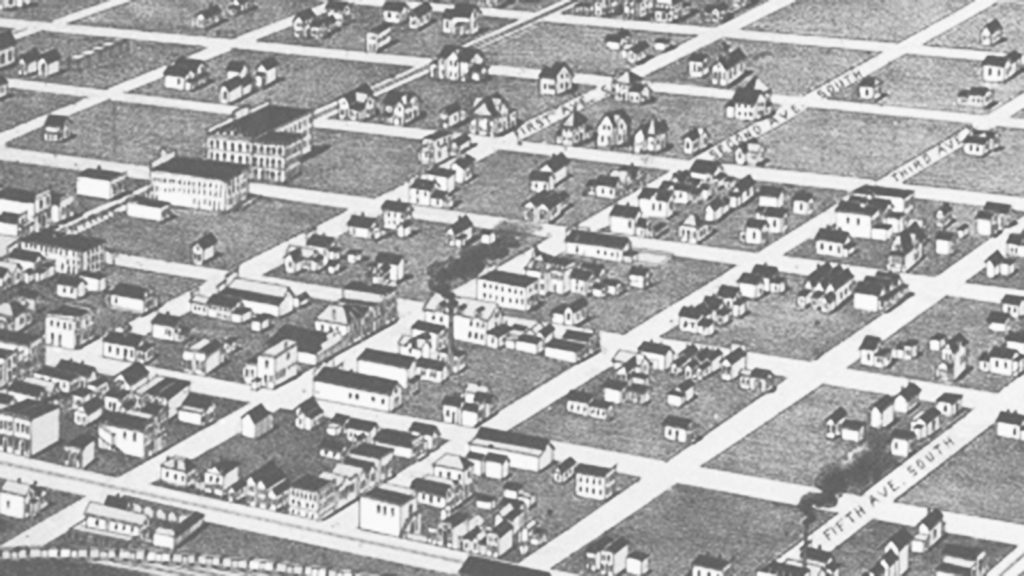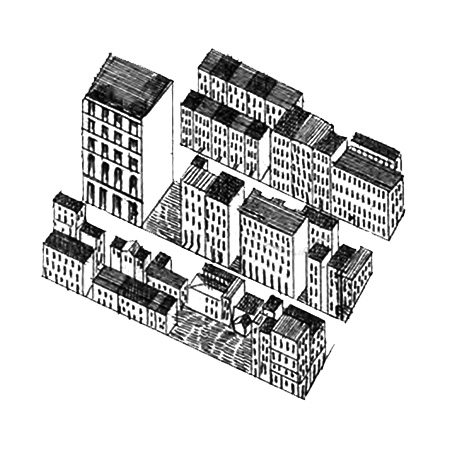
Benefits of the Grid
During the Great American Grid Debate at CNU 21, Kevin Klinkenberg and I sparred valiantly together to defend the grid’s honor against our arch-nemeses Howard Blackson and Bill Dennis. Dozens of spectators observed us as if we were gladiators battling to the death. In the end no one died, but we bickered as if our lives depended on it.
I have organized some of my main arguments from the debate into a simple list describing the benefits of the grid. Why should one use the rectilinear grid today? Here are some points to keep in mind.
1. Walkable
With the proper block size, the grid is inherently walkable. Proper block size is the key term here. Blocks with sides less than about 600 feet and perimeters less than 1,800 feet agglomerate together to form a connected network that behooves everyone whether traveling by foot, car, segway, or stroller. By its very geometry, the grid provides the connectivity necessary for good urbanism.
2. Navigable
Never ask for directions again. The grid gives you an immediate sense of where you are in the world: left-right, east-west, uptown-downtown. As a bonus, it also gives you a sense of distance. As long as you know the unit of measure between intersections, the grid behaves like a giant yard stick.
For example, say you wanted to travel from 200 Street to 800 Street in Salt Lake City. Here is a series of quick calculations you can easily handle in your head before you decide whether or not to spend money on a cab:
- 800 Street minus 200 Street equals 6 blocks
- Each block is 660 feet on a side with 132′ rights-of-way, making the intersection-to-intersection distance 792 feet (about 800 feet)
- 800 feet times 6 blocks equals 4,800 feet, or a little less than a mile
- The average pedestrian walks at a rate of 4.9 feet per second (or about 300 feet per minute)
- 4,800 feet divided by 300 feet per minute is 16 minutes
So not only do you know where you are in the world, you know how far you have to walk and how long it’s going to take you to get to wherever you are going.
3. Adaptable
Land uses change constantly. With rectilinear lots and blocks, old land uses can move out and new land uses can simply plug in.
Take Manhattan, for example. The block at 71st Street and Madison Avenue once accommodated Lenox farm (photo below from the MCNY). Fast forward almost 200 years and that exact same block today accommodates high-rise apartments, office buildings, and art galleries.
Not every block can do this. The next point explains why…
4. Orthogonal
While I may have never met you, dear reader, I am rather confident that I know a lot about you. I bet the screen on which you are reading this sentence is rectangular, I bet the desk the screen is sitting on is rectangular, I bet the room the desk is sitting in is rectangular, and I bet the building the room is sitting in is rectangular. Like it or not, you are surrounded by 90-degree angles: books, boxes, beds, benches, barns, bricks, and blocks.
This may seem like an odd point to make, but the fact of the matter is rectangular blocks accommodate the rectangular objects of our lives extremely well. The Commissioners of New York in 1811 recognized this when they chose the grid for Manhattan:
the right sided and right-angled houses are the most cheap to build and most convenient to live in.
The same holds true for skyscrapers as well.
Orthogonal blocks allow objects and land uses to trade places with ease and efficiency. These geometric efficiencies compound upon each other as you move up in scale:rectangular desks beget rectangular rooms beget rectangular buildings beget rectangular blocks. This leads to the next point…
5. Economical
A rectangular block allows you to do the most with the least. The exact same block in Manhattan has accommodated everything from a farmhouse to a skyscraper. The exact same piece of dirt—now that’s economical!
6. Sustainable
A rectangular block allows you to do the most with the least. The exact same block in Manhattan has accommodated everything from a farmhouse to a skyscraper. The exact same piece of dirt—now that’s sustainable!
7. Appendable
With the grid, the method for expansion is obvious; new developments know exactly what form to take. Since the block is the fundamental unit of the grid, new blocks can append to old in a logical sequence that can theoretically guide development forever.
8. Historical
The grid is a fundamental part of our American heritage. While the grid has been utilized around the world for thousands of years, William Penn introduced it to America in 1682 via Philadelphia. Since then, the grid has made its way across our vast country thanks predominantly to Thomas Jefferson’s 1785 Land Ordinance. Countless others, from greedy developers to Mormon settlers, have followed suit. By utilizing the grid, today’s city planners and urban designers can continue this long lineage of linearity.
In Conclusion…
Simply put, the grid works. It is a two-dimensional organizing framework for urbanism. By using the grid, all of the benefits above are built right into your plan; your urbanism will be off to a great start. Zoning and economy together are responsible for the three-dimensional form that materializes later on top of the grid. This is where things can really go right or wrong. The grid, just like any other form of urbanism, is subject to the successes and failures of urban design, architecture, and all the other considerations that make up our built environment. If you are unhappy with your town, blame your zoning ordinance not the grid.
Do not succumb to the knee-jerk reaction that grids are boring. Instead, take a deep breath, go to Google Earth, and drop the Google-Street-View-Man onto a grid. You will find a variety of places (good, bad, and great) all predicated upon the exact same city plan. The grid can be as wonderful or as terrible as you decide to make it. All I am saying is give grids a chance.





